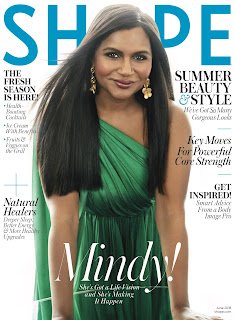The "Arrival" of Mindy Kaling and Why it Matters
When I received my Shape Magazine in the mail last week, I felt a great sense of pride and happiness to see that Mindy Kaling was this month’s cover model. I've been a fan of Mindy from the early days on the Office and have cheered her on from the sidelines as her undeniable talent was uncovered and her success skyrocketed into the super star that she is today. Beyond her talent and skill as a writer and actress, I have been drawn to her because she is one of the only people I have ever watched on television that I felt that I could relate to. After decades of consuming media, Mindy was the first actress that I’ve ever watched that looked (slightly) like me. It was not only inspiring but gratifying to see someone that reminded me of myself on television. Even though Mindy doesn’t know me, she gives me (and millions of other Indian women in this country) representation, and representation matters.
Representation matters. There are approximately 3.5 Million people of Indian origin who reside in this country. Indian people constitute the second largest Asian ethnic group in the United States and Mindy is one of a very select few Indian people in the media that represent this populous ethnic group. Mindy’s presence and representation in the media has worked to humanize and normalize my difference, and has covertly worked to demonstrate that different is not deficient, it's just different (and hey- different can be cool too!). Her presence and success has helped to diminish and negate the stereotypes of Indian people that I faced while growing up in this country when Apu from the Simpsons was the only real media representation that I had. Media representation matters because it is often times a strong influence on how we perceive and make sense of others who we don't have interpesonal interactions with. Even the most educated people buy into stereotypes that are created and maintained by media, so it is important that we have a variety of voices and faces that represent the various culture groups in this country because culture groups are heterogeneous and dynamic, not homogenous or static. In the days when Apu was the only major media representation of Indian people, one of my graduate professors approached me and questioned if it was true that I had "twenty brothers and sisters.” He then followed that statement up with, “what I know about your culture is from watching Apu from the Simpsons.” This disappointing experience was the first time I realized the power and influence that the media has on the ways in which people perceive under-represented identity groups. My professor was a well-intentioned and intelligent person, but hadn't personally known or interacted with Indian people in order to be able to demystify the stereotypes that were created and perpetuated by the character of Apu. I am very grateful that we have come a long way from the days of when Apu was the sole representation of Indian people in this country. Padma Lakshmi, Kamala Harris, Priyanka Chopra, Sanjay Gupta, Lilly Singh, and Aziz Ansari are just a few of the names that join Mindy Kaling in representing and inspiring a whole new generation of Asian Indians Americans.
Mindy’s presence on the cover of Shape Magazine goes beyond representation. She's a trailblazer not only in the film and television industry, but for the millions of South Asian women in this country and throughout the world. She is somebody whose existence is affirmation that it's acceptable and courageous to pave your own path and pursue the career you desire, regardless of what your parents wish for you to become. She reminds us that it's okay and perhaps even empowering to not fit the Indian cultural norms and expectations that so many of us feel pressure to uphold. She's proof that you don't have to be light skinned, a size 2, or look like a Bollywood movie star to be a beautiful, successful, and confident Indian woman. She's an example that serious fashionistas come in all shapes, sizes, and ethnic backgrounds. Finally, Mindy has helped to destigmatize single motherhood as she has shown women across ethnic and racial lines that being married or in a heterosexual relationship isn't a necessary requirement to have a baby.
Mindy’s rise to recognition and fame is something that I celebrate, because her arrival means that we can all “arrive” too. Thank you, Mindy Kaling. You are paving a path that I know many others will follow. ❤❤❤


